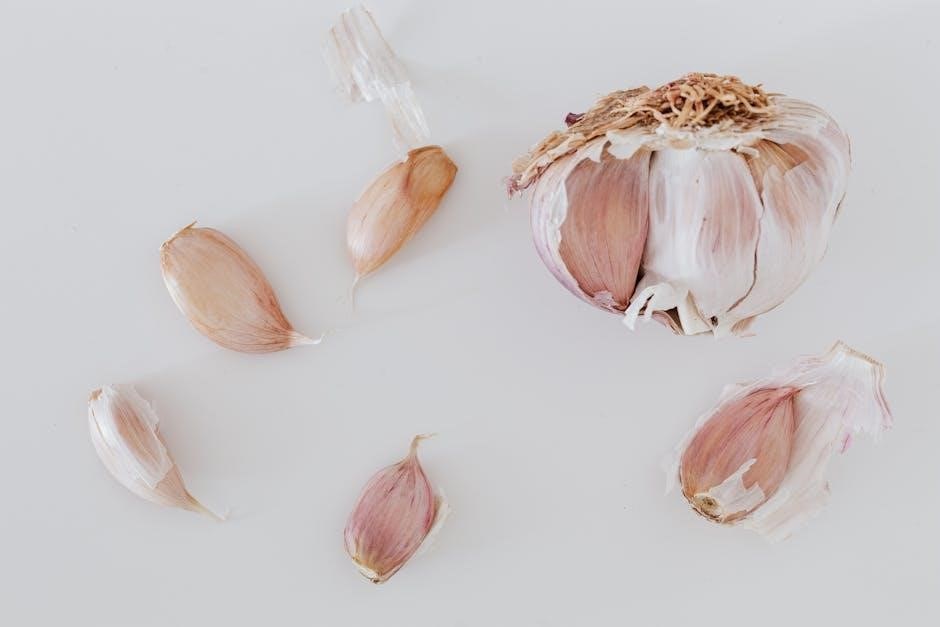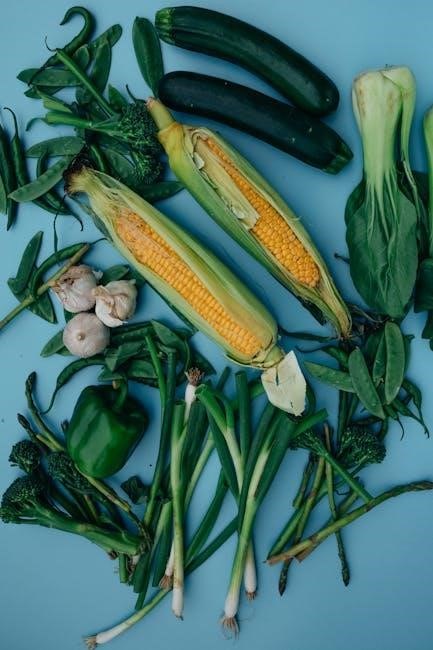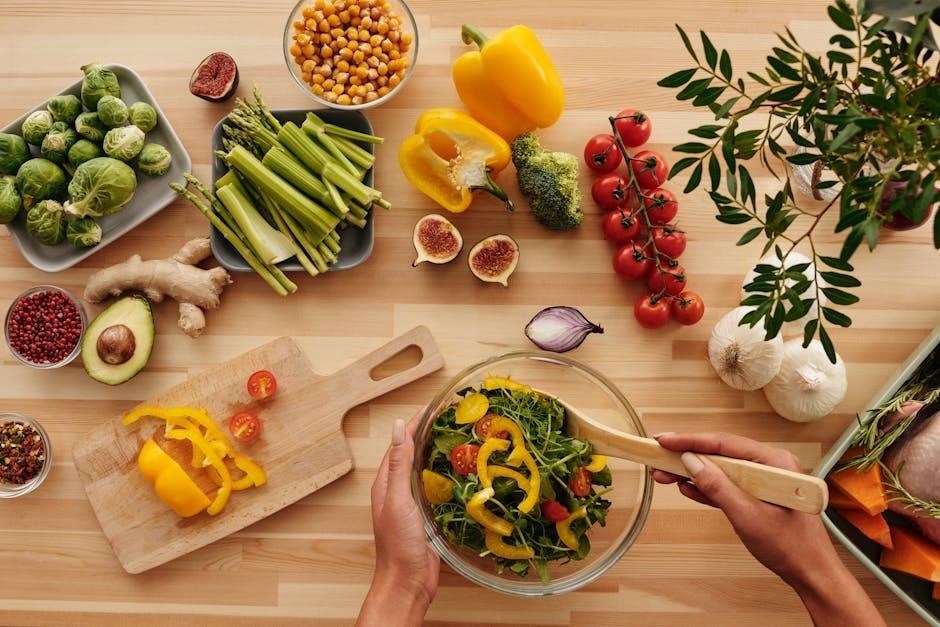Growing garlic is a simple yet rewarding experience, offering fresh flavor and health benefits. Whether you’re a novice or experienced gardener, this guide will walk you through the process of planting, caring for, and harvesting garlic to enjoy year-round.
Why Grow Garlic?
Growing garlic is rewarding and beneficial. It enhances culinary dishes with fresh flavor, promotes health, and naturally deters pests. Garlic is easy to grow, requiring minimal space and care. It’s a low-maintenance crop that thrives in various conditions, making it ideal for gardeners of all levels. Plus, homegrown garlic offers better taste and longer storage compared to store-bought varieties, adding value to your garden and kitchen.
Basic Requirements for Growing Garlic
Growing garlic requires well-draining soil with a pH of 6-7, full sun, and moderate watering. It thrives in cool winters and warm summers, making it suitable for most climates. Garlic is relatively low-maintenance and can grow in various soil types, though fertile, loose soil promotes larger bulbs. Proper spacing and timing are essential for a successful harvest, ensuring each clove has room to develop.

Understanding Garlic Types
Garlic comes in two main types: hardneck and softneck. Hardneck varieties have a central stem, while softneck types are more common and store longer. Both offer unique flavors and growing characteristics, making them suitable for different climates and culinary uses.
Hardneck vs. Softneck Garlic
Hardneck garlic features a central stem, producing fewer cloves (4-6 per bulb) but offering robust, complex flavors. It thrives in colder climates and is often ready to harvest earlier. Softneck garlic, lacking the stem, stores longer and adapts to various climates, making it ideal for braiding. Both types provide unique benefits, with hardneck suited for cold zones and softneck for diverse growing conditions.
Popular Garlic Varieties for Home Gardeners
Popular garlic varieties include Silverskin, known for its mild flavor and long storage life, and Rocambole, offering robust, nutty notes. Elephant garlic, with its large cloves, is ideal for roasting. These varieties are easy to grow, adapt well to home gardens, and provide diverse flavors, making them excellent choices for gardeners seeking a bountiful and flavorful harvest.
Preparing the Soil for Garlic
Garlic thrives in well-draining, fertile soil with a neutral pH. Loosen the soil to 12 inches deep, incorporating compost or aged manure to enrich it. Avoid waterlogged areas to prevent disease and ensure optimal growth.
Optimal Soil pH for Garlic
Garlic grows best in soil with a pH between 6.0 and 7.0, ensuring optimal nutrient availability. A pH outside this range can reduce growth and increase disease risk. Test your soil and amend with lime to raise or sulfur to lower the pH as needed for a healthy crop.
Improving Soil Structure and Drainage
Garlic thrives in well-draining, loose soil to prevent waterlogging and root rot. Incorporate compost or aged manure to enhance soil structure and fertility. For heavy soils, add sand or organic matter. Raised beds are ideal for improving drainage and aeration. Proper soil preparation ensures healthy root development and robust garlic growth, leading to a bountiful harvest.
Choosing the Right Planting Time
Planting garlic at the right time ensures optimal growth. In most regions, fall planting is ideal, while spring planting works better in colder climates with shorter growing seasons.
Planting Garlic in Fall vs. Spring
Planting garlic in fall allows bulbs to establish roots over winter, leading to larger harvests. Spring planting is better for regions with short growing seasons or heavy soil freezing. Fall planting typically occurs 6-8 weeks before the first frost, while spring planting should be done as soon as the soil thaws. Both seasons offer success with proper timing and soil preparation.
Regional Planting Times and Climate Considerations
Planting times vary by region and climate. In cooler climates, garlic is typically planted in fall, 6-8 weeks before the first frost, to allow roots to establish over winter. In warmer climates, spring planting is more common. Hardneck garlic thrives in colder zones, while softneck varieties perform better in milder winters. Check local frost dates and soil conditions to determine the best planting time for your area.
How to Plant Garlic
Plant garlic cloves 4-6 inches apart, 3 inches deep, with the pointed end up and root side down. Space rows 18-24 inches apart for optimal growth.
Preparing Garlic Cloves for Planting
Separate garlic cloves from the bulb just before planting to prevent drying out. Choose healthy, disease-free cloves with intact basal plates for proper root development. Avoid using cloves from store-bought garlic, as they may contain growth inhibitors. Instead, opt for high-quality seed garlic designed for planting. This ensures better germination and flavorful results for your homegrown harvest.
Spacing and Depth Guidelines for Garlic Planting
Plant garlic cloves 4-6 inches apart to prevent overcrowding and promote healthy growth. Sow each clove 2-3 inches deep, with the pointed tip facing upward and the basal plate (flat side) facing down. Rows should be spaced 12-18 inches apart for easy access. Proper spacing and depth ensure adequate root development and airflow, leading to larger, healthier bulbs at harvest time.

Caring for Garlic Plants
Ensure garlic plants receive consistent moisture and mulching to retain soil moisture and suppress weeds. Provide well-draining soil, full sun, and balanced nutrients for optimal growth and flavor.
Watering and Mulching Techniques
Growing garlic requires consistent moisture, especially during bulb formation. Water plants deeply once or twice a week, providing about 1 inch of water. Avoid overwatering, as it can lead to rot. Mulching is essential for retaining soil moisture and suppressing weeds. Apply a 2-3 inch layer of organic mulch like straw or compost after planting, replenishing as needed. This practice promotes healthy root development and flavor.
Fertilizing Garlic Plants
Fertilizing garlic plants is crucial for a robust harvest. Feed the soil with compost or aged manure before planting and again during active growth. Use a balanced fertilizer to promote bulb formation and flavor. Avoid over-fertilizing, as it can reduce bulb quality. Proper timing ensures healthy growth and maximizes your garlic crop’s potential for a successful and flavorful harvest.

Managing Pests and Diseases
Growing garlic requires attention to pests and diseases. Common issues include aphids, mites, and fungal infections like powdery mildew. Regular monitoring and organic pest control methods help ensure a healthy harvest and prevent crop damage.
Common Pests in Garlic Crops
Aphids, spider mites, and onion thrips are common pests that target garlic crops. Aphids can cause curled or distorted leaves, while spider mites lead to bronzed foliage. Onion thrips puncture leaves, reducing plant vigor. Nematodes and bulb flies can also infest garlic, damaging bulbs and underground structures. Regular monitoring and organic pest control methods are essential to protect your garlic crop from these harmful insects.
Preventing and Treating Garlic Diseases
Common garlic diseases include fusarium wilt, powdery mildew, and botrytis rot. Prevention involves crop rotation, proper spacing, and well-draining soil. Treat infections with fungicides or organic alternatives like neem oil. Remove and dispose of infected plants to prevent disease spread. Regularly inspect plants and maintain a clean garden environment to promote healthy growth and minimize the risk of disease outbreaks.

Harvesting Garlic
Gather garlic when tops yellow and fall over, typically in late summer. Carefully dig bulbs, avoiding damage, and check for maturity by inspecting bulb size and formation.
When to Harvest Garlic
Garlic is ready to harvest when the tops turn yellow and fall over, typically in late summer. Use a fork to gently dig around the bulbs, being careful not to damage them. Lift the garlic plants, inspecting the bulbs for size and formation. Harvesting at the right time ensures well-formed bulbs with optimal flavor. Proper timing and technique are essential for a successful garlic harvest.
Proper Harvesting Techniques
Use a garden fork to carefully loosen the soil around the garlic bulbs, taking care not to puncture them. Gently lift the plants, ensuring the entire bulb remains intact. After harvesting, brush off excess soil and avoid washing the bulbs to prevent rot. Handle the garlic gently to maintain its quality and prepare it for curing or storage. Proper technique ensures healthy, flavorful bulbs for year-round enjoyment.

Storing Garlic
Store garlic in a cool, dry place to maintain its flavor and texture. Use airtight containers or paper bags to keep it fresh for several months.
How to Cure Garlic After Harvest
To cure garlic, tie stems in bunches and hang upside down in a warm, dry, well-ventilated area. Keep away from direct sunlight to prevent drying out. Allow 2-4 weeks for the outer skin to dry completely. Once cured, store in a cool, dark place. Avoid washing before curing, as moisture can lead to mold. Proper curing ensures long-term storage and flavor preservation.
Methods for Long-Term Storage
For long-term storage, store cured garlic in a cool, dark, dry place with good ventilation. Use paper bags, breathable containers, or hang in mesh bags. Avoid refrigeration unless garlic is peeled, as moisture can cause spoilage. Freezing is another option—peel cloves, chop, and store in airtight containers or freezer bags. Proper storage ensures garlic remains flavorful and fresh for 6-8 months.

Growing Garlic in Containers or Indoors
Growing garlic in containers or indoors is possible with proper drainage and sunlight. Use deep pots, plant cloves 4-6 inches apart, and keep soil moist but not waterlogged.
Container Gardening Tips for Garlic
Growing garlic in containers requires deep pots with drainage holes to prevent waterlogging. Use well-draining soil and plant cloves 4-6 inches apart, pointy side up. Ensure containers receive full sun and are watered consistently. Mulch around plants to retain moisture and suppress weeds. Avoid overwatering, as this can lead to root rot. Fertilize lightly during the growing season for healthy bulb formation.
How to Grow Garlic Indoors
Growing garlic indoors is possible with proper care. Choose a deep container with drainage holes and fill it with well-draining potting mix. Plant cloves 2-3 inches deep, pointy side up, in a sunny spot. Water moderately and maintain a temperature of 65-75°F. Reduce watering as bulbs mature. Harvest when leaves yellow, and cure indoors for storage. Ensure good air circulation to prevent disease;
Thank you for following this guide! Growing garlic is simple and rewarding. Start with healthy bulbs, ensure proper spacing, and mulch to retain moisture. With these tips, you’ll enjoy a successful harvest. Happy gardening, and don’t hesitate to share your garlic-growing experiences!
Common Mistakes to Avoid
Avoid planting garlic too deeply or too shallow, as this can hinder growth. Overcrowding cloves reduces bulb size, while improper soil preparation leads to poor drainage; Using low-quality garlic bulbs may result in weak growth, and insufficient mulching can expose plants to extreme temperatures. Avoid harvesting too early or late, as this affects flavor and storage quality. Proper timing and care are essential for a successful crop.
Encouragement and Additional Resources
Growing garlic is an easy and rewarding experience, offering fresh flavor and a sense of accomplishment. With proper care, you can enjoy a bountiful harvest and enhance your culinary creations. For further learning, explore gardening websites, YouTube channels, and books for step-by-step guides and expert tips. Join gardening communities to share experiences and gain insights from fellow growers. Happy gardening!
